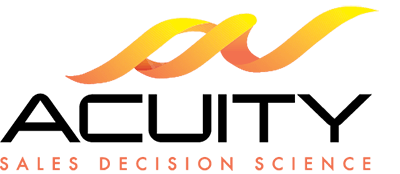What makes a “Good” Predictive Model for Sales?
Most of the focus on “Predictive” these days is on the analytical part, or “scoring”, and data scientists. And accuracy. We need more data scientists, yes… and accuracy matters, but the true value comes from taking action through customer-facing teams. Scores, even accurate ones, by themselves, don’t acquire or retain customers.
What are we trying to predict, anyways?
The Big 4 Business Questions
- Forecasting: Will we hit the number?
- Targeting: Are we focused on the right accounts?
- Retention: How can we keep customers longer?
- Up-sell: What’s the next best offer?
While forecasting is essential for all sales teams, it’s a process for arriving at a diagnostic number used to set expectations. What matters more than the forecast itself is what sales teams do afterwards. They act… but how and why?
All sales teams want to sell more, so we see most attention (and investment in analytics and analytical applications for sales) on #2 through #4, which are action-oriented and directly increase sales.
Answers to all four questions are comprised of a set of attributes related to Accounts (customers and prospects) and Opportunities (deal types and sales stage progression) and Activities (sales and marketing actions) that are correlated to the desired business outcome, such as lead conversion, deal wins, customer growth or retention.
The attributes are stack-ranked from most highly correlated to least, and together they represent a “model”. Just like a forecast, which has an accuracy rating, like +/- 5%, a targeting, retention or up-sell model has a certain accuracy, meaning it can predict the future outcome correctly x% of the time.
Is a “Good” model an accurate one?
Yes. Partially.
So say you have a set of stack-ranked attributes and behaviors that you know are correlated x% with a desired business outcome, like lead qualification or deal closing.
How does that help you sell more?
It doesn’t, by itself.
People have to do something with a model to apply it to their daily activities for the value of the model to be realized in higher sales.
Ranking or “scoring” is only a first step. The model can be used to rank things, like leads, deals and customers. But a list of ranked items is static. When should they be met/called/emailed? How many times? Over what time period? With what value proposition and messaging? How will the sales person know that the sales process has been followed? How will the manager?
Net-net… How a sales rep uses the results of a predictive model is what we mean by application, and this is what drives the value. It’s also helpful to know what has been done, and how that aligns with the sales plan.
The best way to use predictive modeling is through a process that aligns the predictive insight with your sales methodology. At various touch points in your sales process, it’s helpful to know which leads, deals or customers merit more attention, when, and how. Some may be first touches or the umpteenth follow-up to set the demo, if that type of action still has a high probability of leading to a sale.
In summary, a “Good” predictive model for Sales is one that provides a useful insight that is accurate AND that can be readily applied throughout the sales process so that sales reps can benefit from the insight as they engage with customers.
Insight + Action = Results


 © 2020 Acuity Sales Decision Science
© 2020 Acuity Sales Decision Science